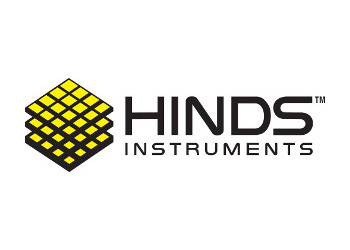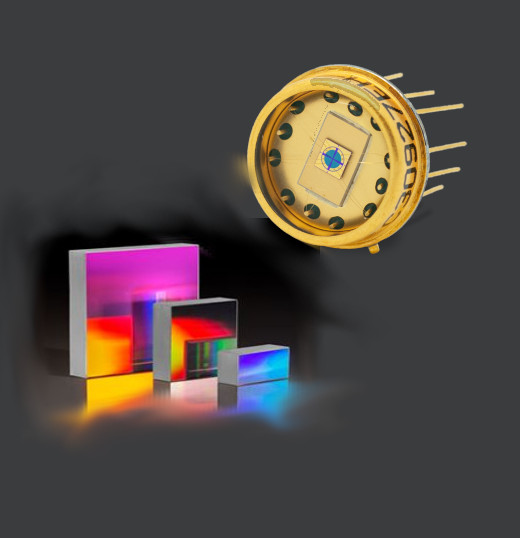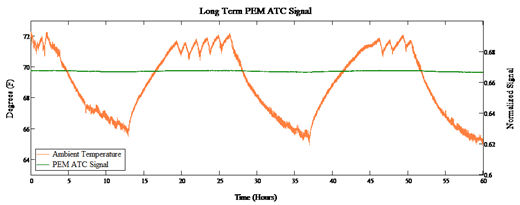Modulator fotoelastyczny

Oferujemy gotowe systemy jak i komponenty
Modulatory fotoelastyczne

Hinds Instruments jest wiodącym na świecie twórcą technologii opartych na zasadach modulacji polaryzacji. Modulatory fotoelastyczne (PEM) to kluczowe elementy w różnorodnych zastosowaniach fotoniki. W związku z tym Hinds stał się kluczowym czynnikiem przyczyniającym się do szerokiego zakresu krytycznych pomiarów opartych na polaryzacji.
Dowiedz się o zasadach działania, unikalnych cechach i trybach działania naszych modulatorów fotoelastycznych tutaj.
PEM są wykonane z izotropowych materiałów optycznych i działają na częstotliwości rezonansowej. Unikalne właściwości PEM obejmują:
czystość polaryzacyjna
duży otwór
możliwość obsługi dużej mocy - do 5 GW/cm2 dla niektórych urządzeń
duży kąt akceptacji
szeroka gama produktów dla różnych obszarów widma, od próżniowego UV po Teraherc
stabilność opóźnienia
trwałość – niektóre PEM są nadal w użyciu od 1977 roku!
Masz pytania ?
PEM-CSC Controller
The PEM-CSC Controller is a hybrid design, utilizing the exceptional capabilities of both the PEM-200 and the PEM-100. This fusion results in a cutting-edge controller that brings together the PEM-100 analog circuit with the PEM-200 digital communication, offering the best of both worlds to offer unparalleled performance and versatility.
Controller Advantages:
- Small Physical Footprint: Measuring 170 mm x 229 mm x 17 mm. Electronic Head: 150mm x 74mm x 33mm
- Simple digital user interfaces that allow for easier entry of retardation and wavelength values
- Easy Connectivity with USB 2.0
- Dual SMAs connect the electronic head to the optical head. (Non CE models only)

Currently Unavailable
Smaller. Lighter. Digital.
Same High Sensitivity.
Same Pure Sinusoidal Function.
Controller Features:
• Improved 50/50 duty cycle, 1f and 2f: 50% ± 1%
• Small Footprint: 62 mm x 135 mm x 174 mm
• Simplified connection – dual SMA cable from optical head to control box
• USB 2.0 and Ethernet Communication
• Low Power requirement - 1.7W (71mA @ 24V), typical.
Optical Head features:
• Models for use from UV – MIR
• High Transmission of Light, for most optics >90%
• High Power Handling Capability, 5 GW/cm2 for most models
• Large Acceptance Angle, as large as +/-40°
• Large Apertures, 16mm to as large as 27mm
• Durability, PEMs built are still in use for over 25 years

The analog PEM100 has been in production from 2005 to 2019
PEM optical heads are classified in three categories according to their design:
SERIES I Optical Head Assemblies
Series I modulators use a rectangular shaped modulator optical element. This optical assembly is designed and built to vibrate at a resonant frequency that is determined by its size. Different optical materials are used to cover the operating range from vacuum UV to near IR.
SERIES II Optical Head Assemblies
Series II modulators use a symmetric or octagonal shape for the modulator optical element. A two-dimensional standing wave in the optical element doubles the retardation available for a given drive voltage. Series II modulators are particularly useful in the infrared spectrum. Hinds application scientists are available to consult on the optimal material and model for your particular experimental setup.
DUAL PEM Systems
Dual PEM systems provide the capability to make real time polarization analysis measurements. When only one PEM is used, two measurements must be made with the sample rotated 45° after the first measurement. However, measurements can be made in real time using two PEMs mounted at 45° with respect to each other.
Hinds Instruments makes modulators for use across many wavelength ranges. Please click on your wavelength range below for more information.
- DUV Modulators (130nm to 400nm)
| Model | Optical | Nominal | Retardation Range | Useful | |
| Material | Frequency | Quarter Wave | Half Wave | Aperture | |
| I/CF50 | Calcium | 50kHz | 130nm-1µm | 130nm-500nm | 16mm |
| Fluoride | |||||
| I/FS20 | Fused | 20kHz | 170nm-2µm | 170nm-1µm | 22mm |
| Silica | |||||
- Visible Modulators (400nm to 750nm)
| Model | Optical | Nominal | Retardation Range | Useful | |
| Material | Frequency | Quarter Wave | Half Wave | Aperture | |
| I/CF50 | Calcium | 50 kHz | 130nm-1µm | 130nm-500nm | 16 mm |
| Fluoride | |||||
| I/FS20 | Fused | 20 kHz | 170nm-2µm | 170nm-1µm | 22 mm |
| Silica | |||||
| II/FS20-A | Fused | 20 kHz | 170nm-2µm | 170nm-1µm | 56 mm |
| Silica | |||||
- NIR Modulators (750nm to 3µm)
| Model | Optical | Nominal | Retardation Range | Useful | |
| Material | Frequency | Quarter Wave | Half Wave | Aperture | |
| I/FS20 | Fused | 20 kHz | 170nm-2µm | 170nm-1µm | 22 mm |
| Silica | |||||
| II/FS20 | Fused | 20 kHz | 170nm-2µm | 170nm-1µm | 56 mm |
| Silica | |||||
- IR Modulators (3µm to 57µm)
| Model | Optical Material | Nominal Frequency | Retardation Range | Useful Aperture | |
| Quarter Wave | Half Wave | ||||
| II/SI40 | Silicon | 40 kHz | FIR–THz | FIR–THz | 36 mm |
| II/SI50 | Silicon | 50 kHz | FIR–THz | FIR–THz | 29 mm |
- Dual PEM Systems
Hinds Instruments announces the PEM-ATC™, a photoelastic modulator with advanced thermal control. This PEM offers long term retardation stability and freedom from drift caused by ambient temperature fluctuations.
Contact us for more information on the PEM-ATC.
The ATC option is available for the following PEM head models:
- I/FS50
- I/FS60
Please contact us about other PEM models and if the ATC is available for that model.
Hinds PEM-ATC:
- PID Controller
- Temperature Sensor
- Internal Heaters
- Feedback Control
- Internal temperature maintained at 32C
The PEM-100 Controller performs many functions in the photoelastic modulator system. Its primary function is to control the peak retardation of the photoelastic modulator optical head.
It does this by providing a DC voltage signal to the electronic head which determines the transducer vibration amplitude and thus the strain amplitude in the optical element. A current feedback loop from the electronic head enables the controller to maintain stable peak retardation levels.
The PEM-100 Controller has many distinct advantages over its predecessor, the PEM-90 Controller:
- Updated user interfaces that allow for easier entry of retardation and wavelength values
- Storage of frequently used settings
- Optional Computer control via proprietary software
- LabView driver for integration into custom user instrument configurations
Options
- Rack Mount, handles only (RMH)
- Rack Mount Extension Kit, with handles (RMO)
- USB Adapter (USB)
- RS232C to IEEE-488 Converter – National Instruments (GPIB-NI)
- Special Length Controller-to-Head Cable (SLCH)

Dual PEM Systems
Dual PEM systems provide the capability to make real time polarization analysis measurements. When only one PEM is used, two measurements must be made with the sample rotated 45° after the first measurement. However, measurements can be made in real time using two PEMs mounted at 45° with respect to each other.
Hinds Instruments has four standard dual PEM choices for applications that require different useful apertures and measurements in different spectral regions. The dual PEM models are:
- PEM 100 I/FS50-60
- PEM 100 II/FS20-23
- PEM 100 II/FS42-47
- PEM 100 II/ZS37-50
| Model | Optical Material | Retardation Range | Useful Aperture | |
| Quarter Wave | Half Wave | |||
| I/FS50-60 | Fused Silica | 170 nm – 2 μm | 170 nm – 1 μm | 16 mm |
| II/FS20-23 | Fused Silica | 400 nm – 2 μm | 400 nm – 1 μm | 56 mm |
| II/FS42-47 | Fused Silica | 400 nm – 2 μm | 400 nm – 2 μm | 27 mm |
| II/ZS37-50 | Zinc Selenide | 2 μm – 18 μm | 1 μm – 10 μm | 14 mm |
The I/FS50-60 (and I/FS50-55, I/FS47-50) system uses the series I PEM. The Series l PEM has a rectangular shaped optic that, in essence, limits the useful aperture of the PEM. These small systems are practical when the light source has a small beam diameter. Therefore, if the application for the dual PEM involves a light source consisting of only one laser, this is a viable option.
The II/FS20-23 and the II/FS42-47 systems also employ high quality fused silica as the optical material and have a transmission range of 170nm to 2.6µm. Both models are completely functional in the visible and near IR light spectral regions. However, the II/FS20-23 system has the benefit of a larger aperture. This is especially useful if the light source has a large beam diameter or more than one light source is to be accommodated. This dual PEM is typically used in a Stokes polarimeter system to measure the orientation of the linear component of light emitted from a beam of deuterium atoms injected into tokamak plasma. The II/42-47 is also used in Stokes polarimetry measurements and provides a more compact optical head configuration.
The II/ZS37-50 has ZnSe as the optical material. This provides a modulating range from 2 μm to 18µm. This PEM pair has applications in the infrared region of the light spectrum. It can be used to analyze either a broadband light source or an infrared laser such as a CO2 laser.
Most of the Dual PEM systems utilize Series II PEMs, which employ octagonal shaped optical elements. The Series II PEMs meet higher requirements for polarization modulation and offer symmetrical distribution of PEM retardation over a larger aperture range.
Like all Hinds PEMs, these systems provide the unique benefit of a wide acceptance angle (> ± 20 degrees), good transmission over a wide wavelength range, high power handling capabilities, and a high polarization sensitivity. The table above compares the technical specifications for all of the standard Hinds dual PEM systems.
OPTIONS
Antireflective Coating (ARC), Custom
Universal PEM Mount (UPM)
Special Calibration Option (SCO)
Special Frequency Option (SFO)

Opcje dla modulatorów fotoelastycznych
Antireflective Coatings (ARC)
Antireflective coatings are used to address modulated interference
effects and to reduce reflection. For more information on this topic,
please read our article on Modulated Interference:
Modulated Interference Effects in Photoelastic Modulators
Standard
- ARC-1, 632.8nm on I/FS50
- ARC-2, 450-650nm on I/FS50
- ARC-3, 3-12μm on II/ZS50
- ARC-4, 3-12μm on II/ZS37
- ARC-5, 8-12μm on II/ZS50
- ARC-6, 8-12μm on II/ZS37
- ARC-7, 633-1000nm on I/FS50
- ARC-8, 800nm on I/FS50
Custom
Please contact us about your custom antireflective coating requirements.
Non-Interference Option (NIO)
The NIO option is an alternative to an AR coating for addressing
modulated interference. The NIO option slightly wedges the optic to
reduce modulated interference effects. For more information on this
topic, please read our article on Modulated Interference:
Modulated Interference Effects in Photoelastic Modulators
- NIO-1, standard on I/FS50
- NIO-2, custom on other Series I optics
Magnetic Field Compatible (MFC)
This option replaces all of the ferromagnetic material in the optical head and extends the length of the cables from the optical head to the electronic head.
Special Frequency Option (SFO)
Contact us if you have a special frequency request.
Special Length Cables
Custom lengths available for Head-to-Head cables (SLHH) and Head-to-Control Cables (SLHC)
Special Calibration Option (SCO)
Special Calibration for Series II PEMs for operation in the UV to visible.
Vacuum Chamber Options (VCO and UHV)
Our standard vacuum chamber (VCO) accommodates the I/CF50 modulator for vacuum UV measurements. Inside the cross chamber a specially designed tray supports the optical assembly so that its position is secure and normal to the light beam.
Also available is a stainless steel optical enclosure for low to ultra high vacuum experiments (UHV) when placing the PEM optics inside your vacuum chamber is preferred. Flanges can also be incorporated into the PEM system if you choose to use your own chamber. Hinds provides flanges for use in both high and low vacuum environments.
Dostawcy








